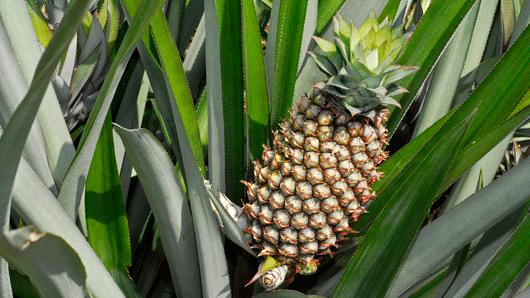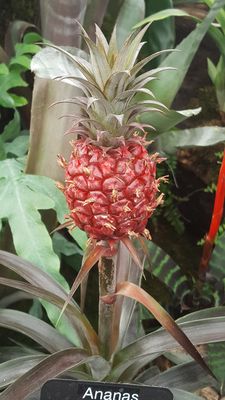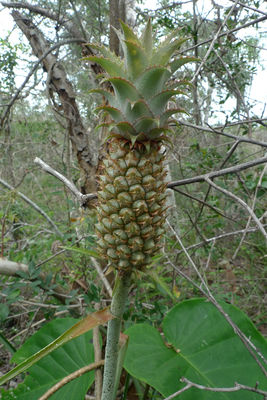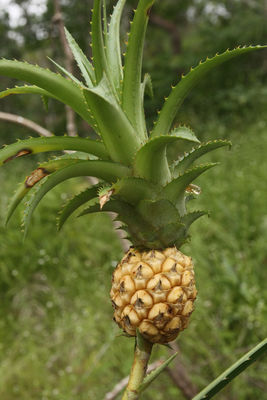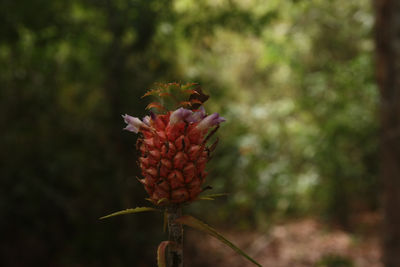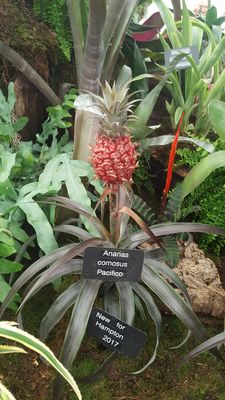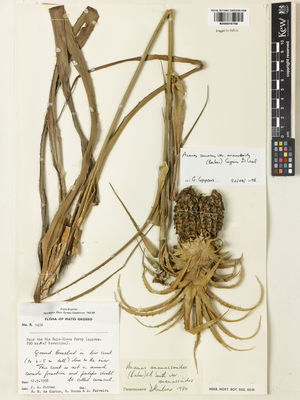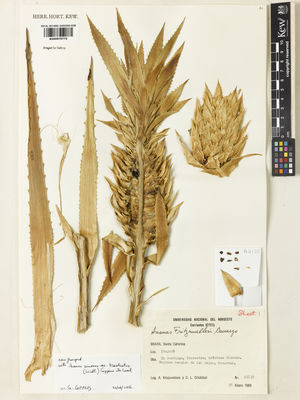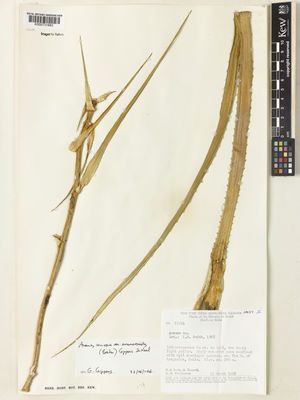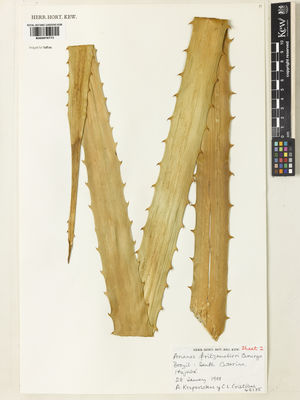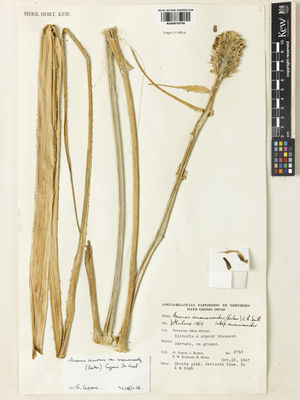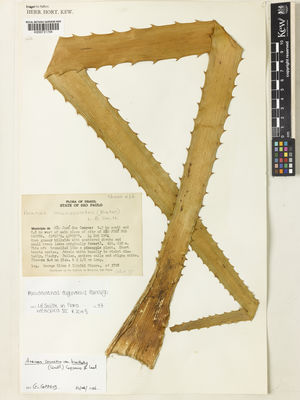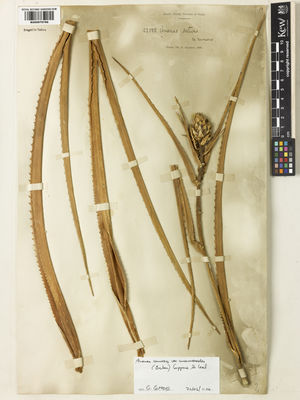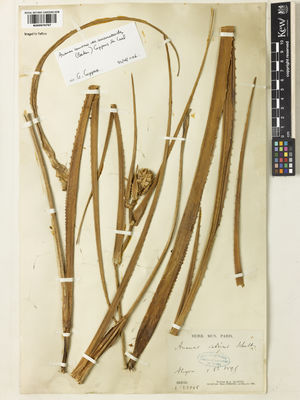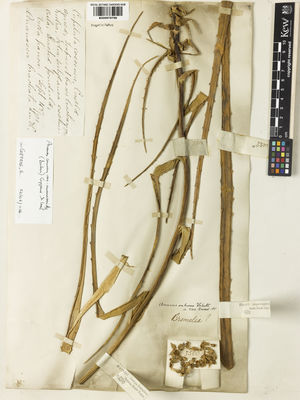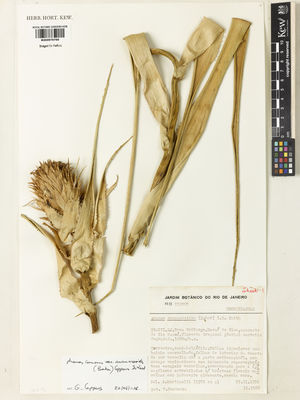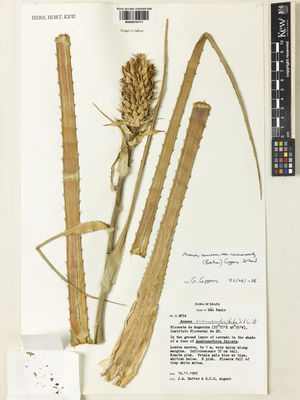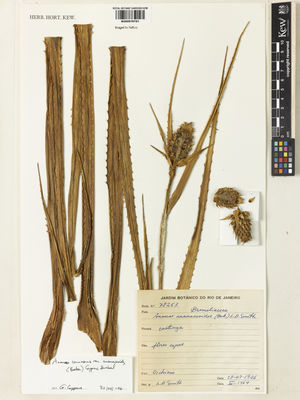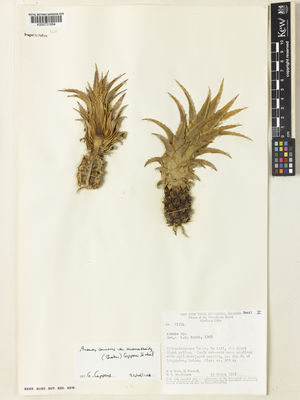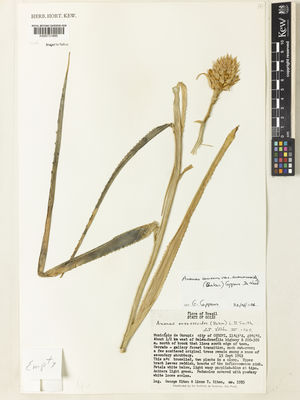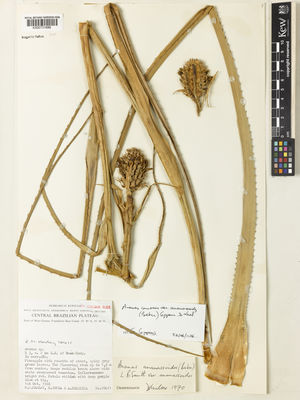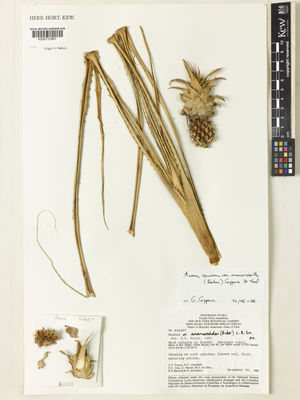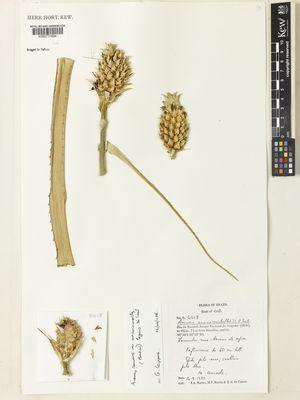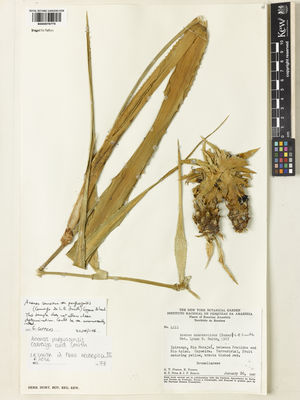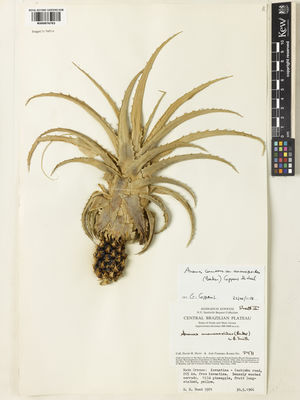Geography and distribution
Ananas comosus is a cultigen from southeastern and southern Brazil and Paraguay, the wild relatives of which are unknown.
Description
Overview: Tropical herbaceous perennial, 1-2 m tall and wide with leaves spirally arranged.
Stem: Circular in cross-section, up to 50 cm long and 8 cm wide, club-shaped.
Leaves: Deep green to grey-green to red, pungent, 30-50 in dense rosettes. Individual leaves up to 1 m long by 4 cm wide with spiny margins.
Flowers: Borne on an inflorescence (flowering structure) 20-30 cm long, held on a scape (stalk) up to 50 cm long and subtended by bracts. Small purple or red flowers are each accompanied by a single red, yellowish or green, fleshy bract. Each flower is composed of three sepals, three petals, six stamens and a three-chambered ovary.
Fruits: A seedless, juicy syncarp (multiple fruit, produced by fusion of fruits from 100-200 flowers) up to 30 cm long, crowned with 20-30 leafy bracts. The tough, waxy rind, made up of hexagonal units, is dark-green, yellow, orange-yellow or reddish when the fruit is ripe. The flesh ranges from nearly white to yellow.
Seeds: Normally only traces of undeveloped seeds are present.
Offshoots, known as 'slips', emerge from the stem around the base of the fruit and 'stem shoots' grow in the axils of the leaves. 'Ground shoots' or 'suckers' are shoots arising from the base of the plant at ground level.
Uses Food and drink
Pineapple was (and still is) an important part of the diet of native Americans in the lowland tropics. The names nanas and ananas were used throughout South America and the Caribbean. Native Americans ate the fresh fruit and also used it to prepare alcoholic beverages such as pineapple wine, chicha and guarapo .
Today, pineapple is the world's third most important cultivated tropical fruit after bananas and citrus. It is grown in frost-free areas around the world for its fruits, which are highly regarded for their distinctive flavour and sweet flesh and juice. Pineapple is an excellent source of vitamins A and C and potassium.
About 30 cultivars are grown commercially and these are grouped into four main classes for convenience in trade: 'Smooth Cayenne', 'Red Spanish', 'Queen' and 'Pernambuco'.
Seventy per cent of the pineapples produced globally are consumed as fresh fruit in the country of origin. Some of the largest producers of pineapple are Thailand, the Philippines, Brazil, China and India. Pineapple is also an important crop in Hawaii, Malaysia and Kenya.
Major pineapple products in global trade are canned slices and chunks, crush, juice and fresh fruit. Cut pineapple is eaten alone or used in desserts, salads, fruit cocktail mixes and cooked meat dishes. Pineapple juice is used in beverages - most famously the mixture of pineapple juice, rum and coconut cream known as piña colada.
Medicine
Native Americans have used pineapple medicinally against parasitic worms and amoebic parasites, to treat stomach complaints and to induce abortion and stimulate menstrual flow. Most of these uses relate to the presence of the enzyme bromelain, which breaks down protein.
Bromelain extracted from pineapple has been used as a nutraceutical (food product thought to provide heath benefits). It has been shown to interfere with the growth of malignant cells, to inhibit clotting, reduce inflammation and help remove damaged tissue from wounds.
Many people react to fresh pineapple with an outbreak of a skin rash or hives. External exposure to juice alone can also cause this reaction in some people. Those who react this way should reduce intake of uncooked fruit or eat only canned fruit.
Fibres
Native Americans used the fibres contained in pineapple leaves and domesticated a smooth-leaved form ( curagua ) with a higher yield of long, strong fibres. These were used to make fishing nets and lines, hammocks and loincloths.
Pineapple fibre is creamy-white with a silky shine and is delicate in texture. It is still used in Brazil and the Philippines, where it is known as piña cloth. It is exported from the Philippines and Taiwan to Spain where it is used for fine embroidery.
Pineapple fibre easily takes and retains dyes and is strong and soft and has been used to make smooth, thin, pliable paper. It is used by cottage industries rather than on a commercial scale, partly because the fibre is difficult to extract and also because the cultivars grown for food do not have leaves suitable for fibre extraction.
Ornamental
Pineapple is cultivated as an ornamental, serving as a stately foliage plant or as a curiosity (with the tempting promise of edible produce). The variegated form is popular as an ornamental.
It was considered fashionable to grow pineapple in Great Britain in the early 1700s, and it served as the model for much garden statuary. An impressive example of pineapple-inspired architecture can be seen at Dunmore Park in Scotland. Built in 1761 by John Murray, the 4th Earl of Dunmore, this folly with its pineapple-shaped cupola originally contained a hothouse but is now maintained as holiday accommodation by The Landmark Trust.
In temperate regions pineapple should be grown in a glasshouse or conservatory, with a minimum temperature of 13-15°C, high humidity and strong sunlight. Plants will not normally produce fruit until they are three years old.
Other uses
Bromelain (an enzyme that breaks down protein) extracted from pineapple has been used as a meat-tenderiser.
By-products of pineapple processing (leaves, bracts, fruit trimmings) have been used in animal feeds, although they are often of low nutritional value.
Pineapple history
Pineapple originated in the lowlands of South America. It was widely used by Native Americans for food, alcoholic beverages and medicinal purposes. By the 15th century, it was distributed throughout most of tropical America, and all forms in cultivation were nearly or completely seedless.
Pineapples were first seen by Europeans when the Italian explorer Christopher Columbus landed on the island of Guadeloupe during his second voyage in 1493. Columbus is alleged to have named the fruit, calling it the 'pine of the Indies' due to its resemblance to a pine cone. The name Ananas derives from nana , a Tupi Indian term for the fruit.
The value of this fruit was soon recognised, and before the end of the 16th century pineapple cultivation had spread across much of the tropical world, including Africa, India, China, Java and the Philippines. In the late 18th century, pineapple was introduced to Hawaii, where it has become the state's most important fruit crop.
Pineapple is now considered to be a weed in some countries.
Cultivation
Pineapple is propagated vegetatively by rooting the coma (crown of bracts at the top of the fruit) or from side shoots produced at the base of the growth.
Some important cultivars are:
• 'Hawaiian King ' - large, smooth-leaved• 'Honey Gold' - large fruit up to 7 kg• 'Smooth Cayenne' - spineless, grown in Hawaii• 'Queen' - spiny, used in Malaysia and Kenya• 'Red Spanish' - used in the West Indies• 'Porteanus' - leaves with central yellow stripe• 'Variegatus' - leaves variegated with longitudinal yellow stripes, sometimes marked red
This species at Kew
Pineapple can be seen growing at the northern end of Kew's Princess of Wales Conservatory, in the moist tropics zone.
Pineapple fibre, thread and cloth and an evening bag and a shirt made from it are held in Kew's Economic Botany Collection. Specimens of pineapple fruit, leaves and oil are also held in the collection and are available to researchers by appointment.

